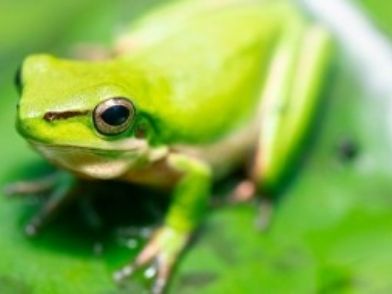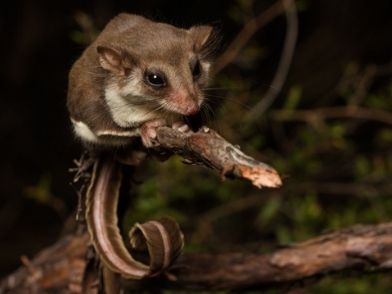Queensland frogs
© Todd Burrows
Queensland has 132 species of frog[1], more than any other Australian state.
The wet coastal areas between Cooktown and the Queensland/New South Wales border — the area with the most rapidly expanding population in Australia — contain 75 per cent of all Queensland frog species. Development in this area causes frog habitat loss and degradation.
In this coastal region, 48 per cent of Queensland’s frog species live below 100 m altitudes. They are the species most threatened by habitat loss and degradation.
The numbers
As of November 2021[2]:
- 11 Queensland frog species are listed as critically endangered
- 7 species are listed as endangered
- 16 species are listed as vulnerable.
QLD frog species listed as critically endangered
- Elegant frog (Cophixalus concinnus)
- Kroombit tinkerfrog (Taudactylus pleione)
- Kroombit treefrog (Litoria kroombitensis)
- Kuranda treefrog (Litoria myola)
- Little waterfall frog (Litoria lorica)
- Mountain mistfrog (Litoria nyakalensis)
- Northern tinkerfrog (Taudactylus rheophilus)
- Rattling nurseryfrog (Cophixalus hosmeri)
- Mount Elliot nurseryfrog (Cophixalus mcdonaldi)
- Mountain nurseryfrog (Cophixalus monticola)
- Bellenden Ker nurseryfrog (Cophixalus neglectus)
QLD frog species listed as endangered
- Common mistfrog (Litoria rheocola)
- Eungella dayfrog (Taudactylus eungellensis)
- Fleay’s barred frog (Mixophyes fleayi)
- Northern gastric brooding frog (Rheobatrachus vitellinus)
- Red-and-yellow mountainfrog (Philoria kundagungan)
- Tapping nursery frog (Cophixalus aenigma)
- Waterfall frog (Litoria nannotis)
QLD frog species listed as vulnerable
- Australian lacelid (Litoria dayi)
- Black Mountain boulderfrog (Cophixalus saxatilis)
- Cape Melville boulderfrog (Cophixalus zweifeli)
- Cape York nurseryfrog (Cophixalus peninsularis)
- Cascade treefrog (Litoria pearsoniana)
- Dainty nurseryfrog (Cophixalus exiguus)
- Giant barred frog (Mixophyes iteratus)
- Magnificent broodfrog (Pseudophryne covacevichae)
- Melville range treefrog (Litoria andiirrmalin)
- New England treefrog (Litoria subglandulosa)
- Northern nurseryfrog (Cophixalus crepitans)
- Tapping green eyed frog (Litoria serrata)
- Tusked frog (Adelotus brevis)
- Wallum froglet (Crinia tinnula)
- Wallum rocketfrog (Litoria freycineti)
- Wallum sedgefrog (Litoria olongburensis)
QLD frog species listed as extinct in the wild
- Sharp-nosed torrent frog (Taudactylus acutirostris)
– last seen 1996 - Southern dayfrog (Taudactylus diurnus)
– last seen 1979 - Southern gastric brooding frog (Rheobatrachus silus)
– last seen in the wild in 1981
The threats
1. Habitat loss
Frogs need native vegetation but they are losing their habitat through:
- Land clearing and urbanisation for housing, industry and associated infrastructure, especially in coastal South East Queensland.
- Intensive agriculture, especially around the coastal lowlands of the Mackay area and the wet tropics.
- Clearing for pine plantations and sand mining.
2. Habitat degradation
Frogs and tadpoles need clean water to breed and grow. Water bodies are becoming less suitable for frogs due to:
- Pollution, including nutrients, runs off from lawns, gardens and agriculture.
- Pesticides, especially in urban areas, are toxic to frogs.
- Weeds from agriculture are taking over frog-friendly wet forests and altering water chemistry.
- Changes in stream and wetland hydrology make wetlands unsuitable for frog breeding.
- Development is disturbing acid sulphate soils, which upsets the water’s pH balance.
3. Global warming
Reduced rainfall and increased temperatures will affect frog species, for example, the Bellenden Ker nurseryfrog only lives on cool mountaintops.
Rising sea levels might affect frogs in coastal areas, for example, the wallum sedgefrog lives only in South East Queensland’s coastal sandy lowlands.
4. Disease
An introduced fungal disease is killing upland rainforest frogs as well as affecting more common species like the green tree frog.
Other exotic diseases will threaten frogs unless we exclude them from Australia.
5. Exotic fish
- Mosquito fish (Gambusia holbrooki), introduced to control mosquito larvae, eat frogspawn and tadpoles.
- Aquarium fish and other exotics are a threat to frogs if released into the wild.
What you can do
- Stop using pesticides and allow natural pest controllers to do their job. Frogs and birds will eat insects, blue tongue lizards will dispose of those snails and do you know that the small insectivorous bats will eat their weight in mosquitoes.
- Create frog-friendly gardens by encouraging naturally occurring trees, shrubs and ground covers.
- Provide a supplementary habitat for frogs in your backyard by building a frog hotel.
- Build a simple frog pond.
- Contribute valuable data for the protection and conservation of frogs by recording the frogs calling around you with the free Australian Museum FrogID app, even if it’s the same frog at the same location every day.
- Lobby local and state governments to value and protect native vegetation, particularly creekside and low-lying areas.
- Lobby local and state governments to control development including managing stormwater runoff and retaining native vegetation.
- Reduce your own greenhouse gas emissions that contribute to global warming.
- Reduce the spread of disease among amphibian populations by not moving frogs and tadpoles from one place to another.
References
- According to the Australian Museum FrogID app (https://www.frogid.net.au/), there are 132 frog species listed as occurring in Queensland.
- Source: Queensland Government Threatened Species Listing report.




